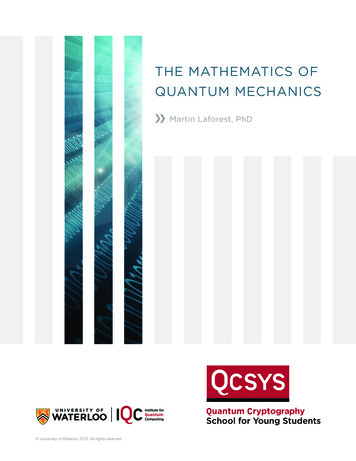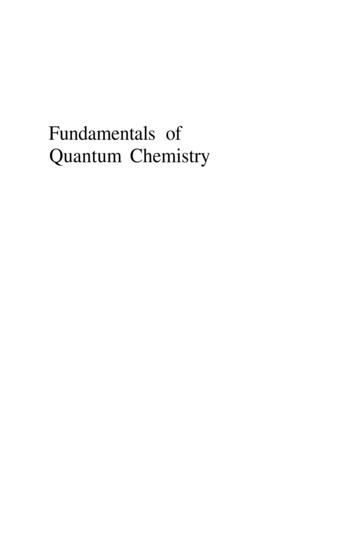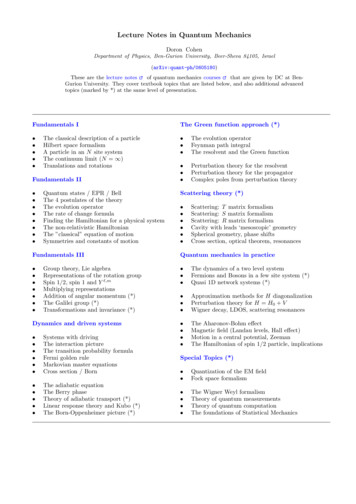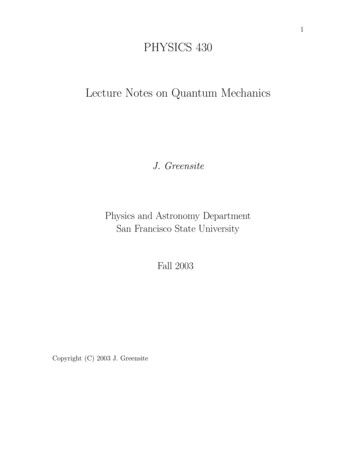
Transcription
the mathematics ofquantum mechanicsMartin Laforest, PhD University of Waterloo 2015. All rights reserved.
ContentsPreface . . . . . . . . . . . . . . . . . . . . . . . . . . . . . . . . . . . . . . . . . . . . . . . 50.1A taste of quantum mechanics60.2Quantum technologies70.3Welcome to QCSYS80.4About the author90.5How to read this book10Complex numbers . . . . . . . . . . . . . . . . . . . . . . . . . . . . . . . . . . . . 131.1What is a complex number?141.2Doing math with complex numbers171.3Euler’s formula and the polar form211.4Summary25Linear algebra . . . . . . . . . . . . . . . . . . . . . . . . . . . . . . . . . . . . . . . . 272.1Vectors282.2Matrices352.3Complex conjugate, transpose and conjugate transpose472.4Inner product and norms502.5Basis552.6Inner product as projection612.7Special matrices662.8The cooking matrix67
42.9Summary70Quantum mechanics . . . . . . . . . . . . . . . . . . . . . . . . . . . . . . . . . . 713.1Mathematical postulates of quantum mechanics723.2New notation: the braket notation733.3Single quantum state and the qubit743.4Quantum measurement773.5Quantum operations813.6Multiple quantum states833.7Observables983.8Summary100Appendices . . . . . . . . . . . . . . . . . . . . . . . . . . . . . . . . . . . . . . . . . 101A.1Greek letters102A.2Properties of complex numbers: Proofs103A.3Euler number and exponential functions107A.4Radians109A.5Proof of Euler’s theorem111
Preface“If quantum mechanics hasn’t profoundly shocked you, youhaven’t understood it yet.”NIELS BOHR“The nineteenth century was known as the machine age, thetwentieth century will go down in history as the informationage. I believe the twenty-first century will be the quantum age.”PAUL DAVIES
6Preface0.1 A taste of quantum mechanicsThe physics describing the world we experience everyday is referred to as “classicalphysics.” It describes how large objects (i.e., objects made of billions and billions ofatoms) interact with each other. Whether it’s the motion of the planets in our solarsystems, the behaviour of a car when you accelerate, what happens when you playbilliards or how electronic circuits work, classical physics is a set of rules that werediscovered and quantified by the likes of Galileo, Newton and many others.Classical physics is a tremendously successful theory of nature and has led toastonishing human feats. We put a man on the moon, built bridges, skyscrapers,supersonic jets, developed wireless communication, etc. The fascinating part is thatclassical physics is not the ultimate description of nature – there is much more toreality than what we see and experience.If we try to describe the behaviour of atoms and their constituents (e.g., protons,neutrons, electrons) using the laws of classical physics, it completely, and I meancompletely, fails. Actually, if we described the motion of electrons around thenucleus of an atom using classical principles, you can calculate that any atom wouldcollapse within a tiny fraction of a second. Obviously, the world we live in is madeof stable atoms. . . so what’s going on?Well, it turns out that classical physics is only an approximation of physics thatworks for large objects. In order to describe the behaviour of the building blocksof nature, we need a radically different approach that, as you’ll learn, leads tosurprising and fascinating new phenomena: welcome to the beautiful world ofquantum mechanics!Particles behave like waves and waves behave like particles. Electrons tunnelthrough barriers. It’s impossible to perform a measurement without perturbing theenvironment. Quantum entangled photons are so strongly interconnected that theybehave as one, no matter how far apart they are. These are all part of everyday life inthe quantum world.Quantum mechanics can be baffling, yes, surprising, definitely, and certainlycounter-intuitive. That’s because quantum mechanics lives outside of our everydaylives and any attempt to explain quantum phenomena using classical physics fails.Quantum mechanics just is, and it’s awesome!Turns out that quantum mechanics isn’t really that complicated, we just need toexperience it and build an intuition about it. Quantum mechanics opens a doorto a world that may surprise you; a world where the rules of the game are different.Much different.Developed in the first half of the 20th century by the likes of Max Planck, ErwinSchrödinger, Werner Heseinberg, Paul Dirac and many others, the theory of quantummechanics (also called quantum theory) never ceases to amaze us, even to this day.
0.2: Quantum technologiesAt the time, quantum mechanics was revolutionary and controversial. Even a geniuslike Albert Einstein thought it couldn’t be a serious theory. Unfortunately for him, hewas wrong!An astonishing amount of experiments have been performed in the last few decadesdemonstrating the validity of quantum theory. As a matter of fact, we can safelyclaim that quantum theory is the most accurate theory ever developed by mankind.Every attempt to prove it wrong has failed miserably.You may have already heard about wave-particle duality. It’s one of the mostquintessential phenomena of quantum. Sometimes an electron (or any other quantumobject) behaves like a particle, sometimes it behaves like a wave. How do you knowwhen you should treat the electron like a wave, and when you should treat it like aparticle? Part of the beauty of quantum mechanics is that we don’t need to make thatdistinction - it’s all contained within the theory.A final note: Not only does quantum mechanics accurately describe the behaviourof atoms and molecules, it can actually describe nature at any scale. The only reasonwe don’t really need quantum mechanics to describe large objects is because thequantum effects play such a small role that they can be ignored, and classical physicsrepresent an accurate approximation. Though that doesn’t mean quantum effectscan’t be observed in larger objects, such as superconductors (material conductingelectricity with zero resistance), nano-size electrical circuits and transistors, just toname a few.0.2 Quantum technologiesQuantum mechanics has already had a tremendous impact on our lives. Not onlydoes it tell us how the world behaves at its core – at the atomic level and beyond –but it has led to transformative technologies that have shaped, and continue to shape,the 20th and 21st centuries. The laser, LEDs, magnetic resonance imaging (MRI),transistors and so much more, all exist because the world behaves according to therules of quantum mechanics.What would a world be like without lasers? Well, there would be no internet. Howabout a world with no transistors? Well, every single piece of digital technology –computers, mp3 players, smartphones, digital cable tv – wouldn’t exist! The worldwould be radically different.Speaking of digital technology, the digital world we now live in has been madepossible thanks largely to information theory. All the digital technology mentionedabove really boils down to one thing: information processing. Yes, their applicationsare vastly different from one another, but at their core, in their processor, theymanipulate bits of information.7
8PrefaceA second quantum revolution is underway, the “Quantum Information Revolution”,where we manipulate information in a quantum mechanical fashion. This revolutionis more than just an idea – small prototypes of quantum computers exist (you’ll evensee some of them at the Institute for Quantum Computing (IQC), stable quantumcryptography systems are commercially available used by government and banksaround the world, quantum sensors are bursting out of our labs and used in medicine,material science, resource exploration and other fields.0.3 Welcome to QCSYSDuring the Quantum Cryptography School for Young Students (QCSYS or“cue-see-sis”), you’ll become familiar with a special type of quantum technology:quantum cryptography, or more precisely, Quantum Key Distribution (QKD).Nowadays, when secure information is being sent over the internet (banktransactions, your password when you log in to your favourite social media website,etc.) your information remains private. The privacy of the information is ensured bythe fact that no computer on earth can solve, in a reasonable amount of time (e.g.,hundreds to thousands of years!), a given, really difficult mathematical problem. Theeventual arrival of the ridiculously powerful quantum computer will render thesecryptographic techniques obsolete.Thankfully, quantum mechanics also comes to the rescue: quantum cryptography.By exploiting the behaviour of the quantum world, we can secure information suchthat the only way for an all-evil eavesdropper to access this information would be tobreak the rules of physics. We’re pretty confident nobody can do that. Ever!During QCSYS, you’ll learn the basic concepts behind quantum cryptography; fromquantum mechanics and classical cryptography, to quantum optics, and of course,quantum cryptography. QCSYS started in 2007 with many goals and challenges inmind. Passionate about the science and research we do at IQC, we wanted to shareit with future scientists, mathematicians and engineers (that would be you). Also,since quantum mechanics and quantum technologies will play a key role in shapingthe technological landscape of the 21st century, we strongly believe it’s important forthe new generation to be “quantum-aware”. Last, but not the least, it was a challengewe gave ourselves: can we teach quantum mechanics and quantum information tohigh school students? Quantum cryptography is a tiny subset of potential quantumtechnologies, but it offers a great vehicle to teach young students about technology,information security, mathematics, quantum mechanics and quantum computing.We’ll repeat it many times: quantum physics isn’t about mathematics, it’s about thebehaviour of nature at its core. But since mathematics is the language of nature, it’srequired to quantify the prediction of quantum mechanics. This present documenthas been put together to ease you into the mathematics of quantum mechanics. We’lluse special mathematics – complex numbers and linear algebra (vectors andmatrices). Unfortunately, most high school mathematics curricula around the world
0.4: About the authordo not teach linear algebra. It’s not very complicated. It’s really just a different andclever way to add and multiply numbers together, but it’s a very powerful tool.We don’t claim to cover all of linear algebra in a rigorous way, nor do we claim thatthis is the only way to do quantum mechanics. There are different mathematicalapproaches, but the one described here is very well suited for quantum informationand quantum cryptography, and fairly simple (we hope) to understand.I encourage you to read through this book before you come to Waterloo for QCSYS.Do not panic if it feels like it’s over your head or you’re struggling with some of theconcepts. We’ll spend at least five hours going through the key sections of the bookand work through exercises in groups. QCSYS counsellors, graduate students and Iwill be on hand during QCSYS to help you out.In addition to the mathematics of quantum mechanics, we’ll spend another five hoursexploring the “physics” of quantum mechanics. We’ll first explain the behaviour ofquantum particles without quantifying it. We’ll then consolidate the two so you havea good understanding of how we use mathematics to model the physical quantumworld. After this introduction, we’ll be ready to learn about cryptography, quantumoptics, quantum cryptography (of course) and even quantum hacking. We’ll also goin the labs and do some experiments. You’ll even have the chance to build your ownquantum cryptography system!A little note before getting into the heart of the subject: I would like to thank thepeople who helped me put this document together. The starting point of thismathematical primer was a set of class notes put together a few years ago by a thengraduate student at IQC – Jamie Sikora. Jamie was one of the first teachers ofQCSYS and we owe him greatly. Thanks also to Juan-Miguel Arrazola for providinggreat feedback on earlier versions of this book and Jodi Szimanski and Kathryn Fedyfor proofreading and editing.Finally, welcome to QCSYS, welcome to the Institute for Quantum Computing andwelcome to Waterloo. We sincerely hope you’ll have a great time, learn a lot andbuild new friendships that will last forever.0.4 About the authorMartin Laforest is the Senior Manager, Scientific Outreach atthe Institute for Quantum Computing, University of Waterloo,Canada. Officially, Martin’s role is to bring science out of thelab and into peoples lives. Unofficially, he’s the talkative guywho’s passionate about quantum science and technology andlikes to share it with young minds. Martin leads IQC’s youthoutreach programs including the Undergraduate School on9
10PrefaceExperimental Quantum Information Processing (USEQIP) and the QuantumCryptography School for Young Students (QCSYS).Martin has always been fascinated by trying to understand how the world works.That led him to earn an undergraduate degree in Mathematics and Physics at McGillUniversity and later, a PhD in quantum physics from the University of Waterloo.Before starting his current position at IQC, Martin spent two years doing research atthe Delft University of Technology in the Netherlands.0.5 How to read this bookWe understand that a lot of material in this book will be new to you. In order tomake it as easy to read as possible, we came up with a series of notations to helpyou. The material in each chapter has been classified using six different categories.Notice how some of them are numbered for easy reference. We’ll list them belowand use the concept of mathematical sets (which isn’t something we need to know tounderstand the rest of the book) to give examples.DefinitionsSince mathematics is a man-made construction, we’ll introduce each newmathematical concept by highlighting them in a box as follows:DEFINITION 0.5.1: Mathematical sets. In mathematics, a set is acollection of distinct objects. A set is also considered an object in its ownright. If we have objects a, b and c, the set containing these three objects,denoted S, would be written using the following notation:S {a, b, c}ExamplesThis book includes loads of examples. We believe concrete examples can helpsolidify your understanding of new mathematical concepts. Some of them are rathertrivial, some of them are quite hard – designed to make you think a little. Examplesare also highlighted using a box as follows:EXAMPLE 0.1: Suppose we have the number 42, a cat and planet Mars,then the collectionS {42, cat, Mars}is a set containing 3 objects. Since S is also an object, the collectionS0 {42, cat, Mars, S}is a set containing 4 objects.
0.5: How to read this bookYou’ll also notice that there aren’t any exercises. This is by design. We’ll spend a lotof time during QCSYS solving problems in group. You’re therefore stronglyencouraged to try to solve the examples before completely reading through them.ObservationsWe use this category to stress intuitive conclusions that can be derived from adefinition or an example. They’ll help further your understanding of certainapplications of new concepts.Observation 0.5.2: A set must be seen as a collection of object, thereforeit doesn’t matter in which order the objects are listed. That is to say, the sets{42, cat, Mars} and {cat, 42, Mars} are the exact same set.NotesWe use these to bring your attention to something we want to make sure you didn’tmiss or to give you a little extra information. Notes are written in the outer margin ofthe page as you can see on the right.Food for thoughtThese are designed to be brain teasers, to make you think a little harder, a littledeeper, maybe even make you obsess. See if you can answer them. Just like notes,they’re also found in the outer margin as you can see on the right.Trivia factsThese will give you interesting facts about some concepts you’ve just learned. Theyare complementary to the rest of the material and aren’t necessarily needed tounderstand the upcoming material. They’re also found in the outer margins.Finally, one thing you’ll notice is that there are a lot of equations. It’s a mathematicsbook after all. Some of the equations will be boxed, for example:E mc2These boxed equations are particularly important, so pay close attention to them.They’re also summarized at the end of each chapter.Now, get to the first chapter and have a good read!Note 0.5.3Objects in a set don’t haveto be of the same nature. For example,the set S in Example 0.1 contains anumber, a planet inhabited solely byrobots and the best/worst house petthere is.Food for thoughtWe saw that, bydefinition, a set is an object on its ownright. Therefore, does the “set of all sets”exist? Explain why.Trivia factSet theory is the modernstudy of sets initiated by Georg Cantorand Richard Dedekind in the 1870s. It’scommonly employed as a foundationalsystem for mathematics, that is to say aseries of definition and rules (known asaxioms, or postulates) designed to studythe logical basis of mathematics.11
Chapter 1:Complex numbers“I tell you, with complex numbers you can do anything.”JOHN DERBYSHIRE“Mathematics is the tool specially suited for dealing withabstract concepts of any kind and there is no limit to its powerin this field.”PAUL DIRAC
14Chapter 1: Complex numbers 22The number system we all know and love, like 10, 2, 0.3, 2, , π and of course,7the answer to life, the universe and everything, 42, are known as the real numbers.Conventionally, we denote the family of all numbers as R.But, sometimes, real numbers aren’t sufficient. Below is an example that might be alltoo familiar.EXAMPLE 1.1: Recall that the solution to any quadratic equation of the formax2 bx c 0, is given by: b b2 4acx 2aIf we try to solve the quadratic equation x2 5x 10 0 for x, we’ll get: 5 25 4 · 10x 2 5 15 2 What’s the value for 15? In other words, is there a real number a such that a2 15? It’s not hard to convince yourself that, in fact, no real numbers, being positiveor negative, can satisfy this condition.Should we just give up? Of course not! We’re doing mathematics: if somethingdoesn’t exist, we invent it! This is where complex numbers come in. If you pursueyour studies in virtually any field of science and/or engineering, chances are complexnumbers will become your best friends. They have many applications in physics,chemistry, biology, electrical engineering, statistics, and even finance and economics.As you’ll learn soon enough, in quantum mechanics, complex numbers areabsolutely everywhere.1.1 What is a complex number?In some sense, we’ve already defined what a complex number is. In the example above, since 15 is not real, then x is certainly not real either. (Adding a realnumber with a non-real number cannot give you something real!) So by definition,we’ll call numbers like this complex numbers.But of course, being mathematicians-in-training, we’d like to have something moreconcrete, better defined. Looking at x again, all the kerfuffle seems to be caused bythe nasty minus sign under the square root. Let’s take care of that.
1.1: What is a complex number?DEFINITION 1.1.1: Imaginary unit number. We define the imaginary unitnumber i as the square root of -1, that is:i 1This definition might look arbitrary at first, but mathematics is an abstract subjectand as long as we’re consistent, we’re free to define anything we want!EXAMPLE 1.2: Using our new definition for the square root of -1, it’s nowpossible to write: 15 1 · 15 1 15 i 15 3.87iDEFINITION 1.1.2: Imaginary numbers. A number is said to be imaginary ifits square is negative.EXAMPLE 1.3: 2 15 is an imaginary number because 15 15 EXAMPLE 1.4: Let’s look at the same example using our new notation. i 15is, of course, an imaginary number because: 2 215i 15 i2 · 2 1 · 15 1 · 15 15Now that we’ve defined imaginary numbers, we finally can define complex numbers.DEFINITION 1.1.3: Complex numbers. A complex number is any numberwritten in the form:z a biwhere a and b are real numbers. a is known as the “real part” of z, and b as the“imaginary part”. We also define Re(z) and Im(z) as follows:Re(z) aIm(z) bTrivia factThe use of i to denote the imaginaryunit number is used in most scientificfields, but if you end up studying electricalengineering, chances are you’ll know itas j, since i is a variable denoting theelectrical current. But for now, let’s stick toour regular convention.15
16Chapter 1: Complex numbersTrivia factItalian mathematician Gerolamo Cardanois the first known person to have definedand used complex numbers. That waswaaaay back in the 16th century. Cardanowas trying to solutions to equations of theform x3 ax c 0.The family of all complex numbers is denoted by C. Since a real number is acomplex number without an imaginary part, we have R C; this means “R isincluded in C.”EXAMPLE 1.5: Let’s solve again the quadratic equation x2 5x 10 0 for x.As before, we have: 5 25 4 · 10x 2 5 15 2 5 15 1 2 515 i22There’s a very nice way to graphically represent complex numbers as long as yourealize that real numbers and imaginary numbers are exclusive. That is to say, a realnumber has no imaginary part, and an imaginary number has no real part. This issimilar to cartesian coordinates (i.e., a point on the x-axis has no y component andvice versa). For this reason we can use the cartesian plane to represent and visualizea complex number:Figure 1.1: Using the complex plane, we can visualize any complex number z as apoint on a two-dimensional plane. Represented here is the number z 3 5i.
1.2: Doing math with complex numbersDEFINITION 1.1.4: Complex plane. We can visualize a complex number asbeing a point in the complex plane, such that the x-axis represents the real part ofthe number and the y-axis represents the imaginary part.EXAMPLE 1.6: Looking at Figure 1.1 on previous page, the number z 3 5iis represented on the cartesian plane. The real part of z, 3, is the projection ofthat point on the “real axis”, while the imaginary part of z, 5, is the projection ofz along the “imaginary axis”.1.2 Doing math with complex numbersJust like with real numbers, we can add and multiply complex numbers. (We’ll seelater how to divide them.)DEFINITION 1.2.1: Complex addition and multiplication. Consider thecomplex numbers z a bi and w c di, where a, b, c and d are real numbers.Then we can define:1. Complex addition:z w (a bi) (c di) (a c) (b d)i2. Complex multiplication:zw (a bi)(c di) ac adi bci bdi2 (ac bd) (ad bc)i(recalling that i2 1)Note 1: In the last step of the multiplication above, we’ve gathered the real part andthe imaginary part together.Note 2: The method used for the multiplication of two complex numbers issometimes also referred to as the FOIL method (First-Outer-Inner-Last).EXAMPLE 1.7: Consider the following examples using the complex numbersz 1 3i and w 2 i:z w (1 3i) ( 2 i) 1 4izw (1 3i)( 2 i) 2 i 6i 3i217
18Chapter 1: Complex numbers 2 5i 3 5 5iNow that we know how to add and multiply complex numbers, we’ll introduce someuseful definitions and properties. They might seem a little arbitrary at first. But asyou’ll soon see, these will become very handy, especially when we start using themin quantum mechanics.DEFINITION 1.2.2: Complex conjugate. We define the complex conjugate ofa complex number z a bi, denoted z̄ (notice the over bar), as:z̄ a biEXAMPLE 1.8: Let’s calculate some complex conjugates:Food for thoughtReferring to the complex plane, what kindof geometric operation (e.g., translation,rotation, etc.) does taking the complexconjugate of a number represent?1.2.3.4.If z 5 10i, then z̄ 5 10iIf z 3 2i, then z̄ 3 2iIf z 3, then z̄ 3 (the complex conjugate of a real number is itself)If z 2i 0 2i, then z̄ 2i (the complex conjugate of an imaginarynumber is minus itself)DEFINITION 1.2.3: Modulus. The modulus (or length) of a complex numberz a bi is given by: z pa2 b2Since both a and b are real, the modulus is always real and positive.EXAMPLE 1.9: Let’s calculate the moduli of the following complex numbers.Note 1.2.4The modulus of a complex number is asimilar concept to the absolute value of areal number.1.2.3.4. If z 5 10i, then z 52 102 125p If z 3 2i, then z 32 ( 2)2 13p If z 3, then z ( 3)2 02 9 3 (This is the absolute value!) If z 2i, then z 02 22 4 2Observation 1.2.5: Modulus in the complex plane. By looking at therepresentation of a complex number on the complex plane (see Figure 1.2 on page19), the modulus of the number is simply the distance from the origin 0 0i to thenumber. (Hence why we also call it the length of the number.)Observation 1.2.6: Complex conjugate and modulus. Notice the very usefulapplication of the complex conjugate: Given z a bi, we see that:zz̄ (a bi)(a bi) a2 abi abi ( i)ib2
1.2: Doing math with complex numbersFigure 1.2: The modulus, or length, of a complex number is the distance betweenthe origin (0 0i) and the point representing z. a2 b2 z 2 z zz̄It seems like we’re in good shape to play around with complex numbers, but what ifsomeone asked you to divide by a complex number? For example, what’s the valueof a number like:1 i?2 iFirst question: Does it even make sense to divide by a complex number? Recall thatjust like subtraction is the same thing as addition (i.e., subtraction is really justadding a negative number), division is the same thing as multiplication. Dividing xby y is really just a fancy way of saying, “how many times do I have to multiply y toget x?” Since multiplication is well defined for complex numbers, so is division.To help you visualize division by complex numbers so that you develop an intuitionabout it, we’ll use a little trick.Observation 1.2.7: Complex division. Since multiplication is well defined forcomplex numbers, so is complex division. Given a complex number z a bi,19
20Chapter 1: Complex numbersas long as z 6 0 0i, observe that:1 1 z̄ ·(we’re just multiplying by 1)zz z̄z̄ 2 z a bi 2a b2abi 2 a b2 a2 b2Since the a2 b2 is a real number, we found a way to expressform c di, where:1in the usual complexzaa2 b2 bd 2a b2c Trivia factWe just learned that complex numbers areessentially an extension of real numbers.A natural question to ask: Is there anextension to complex numbers? Turnsout yes! The Quaternions – otherwiseknown as H. Quaternions are a numbersystem extending complex numberswith the important distinction that they’renon-commutative, that is, if a and b arearbitrary quaternion, ab isn’t necessarilyequal to ba. Just like a complex numbercan be visualized as being a point ofa plane (i.e., a 2-dimensional surface),quaternions are points in a 4-dimensional“hyperspace”. Quaternions are veryuseful in applied mathematics, physics,computer graphics and computer vision.Is there an extension to quaternions? Ofcourse there is! The Octonions, or O.Not only are octonions non-commutative,they’re are also non-associative, that is ifa, b and c are octonions, then (a b) cis not necessarily equal to a (b c).Octonions can be seen as a point in a 8dimensional hyperspace. Although not asstudied as quaternions, octonions do havesome applications in string theory andspecial relativity.How about an extension to octonions?Sadly, it doesn’t exist.Note that1is also written as z 1 .zEXAMPLE 1.10: We can clean up the fraction1 ias:2 i1 i (1 i) (2 i) ·2 i (2 i) (2 i)1 3i 51 3 i5 5Properties 1.2.8: Summary of complex numbers properties. Below is asummary list of properties for complex numbers. Feel free to prove them foryourself if you’re not convinced, or refer to appendix A.2 on page 103. Let zand w be any complex numbers:z w w z(commutativity of addition)zw wz(commutativity of multiplication)z w z wzw z̄w̄zz̄ z̄z z 2z z z z zw z w (known as the triangle inequality) z w z w 1z̄10. z 1 2 when z 6 0 0iz z 1.2.3.4.5.6.7.8.9.
1.3: Euler’s formula and the polar form1.3 Euler’s formula and the polar formSo far, we’ve explicitly written any complex number z in the form z a bi. As youmay have noticed, this form is not particularly well suited for multiplying anddividing complex numbers (which we do a lot in quantum mechanics). Thankfully,there’s a different way of handling complex numbers. In order to understand thismethod, you’ll need to be familiar with the exponential function ex , as well astrigonometric functions using radians instead of degrees. If you’re not familiar witheither of those, consult Appendices A.3 and A.4, on pages 107 and 109 respectively,before continuing.DEFINITION 1.3.1: Euler’s formula. Euler’s formula is a well-known result forcomplex numbers, establishing a deep relationship between trigonometricfunctions and complex exponentials. It states that:eiθ cos θ i sin θwhere θ is a real number and in radians (i.e., unitless). The proof of Euler’sformula is not particularly complicated, but it does require the knowledge ofTaylor Series. If you don’t have this knowledge, or you’re curious, visitAppendix A.5 on page 111.Observation 1.3.2: Polar form of complex numbers. Any complex number z a bi can be written in the form:z z eiθwhere z is the modulus of z as previously defined on page 18 and θ is the angle(in radian) between the real axis and the complex number in the complex plane (seeFigure 1.3 on page 22). Therefore: bab, or θ arcsin, or θ arccosθ arctana z z The angle θ is known as the argument of the complex number.You can convince yourself that the polar form notation is equivalent
Quantum mechanics can be baffling, yes, surprising, definitely, and certainly counter-intuitive. That’s because quantum mechanics lives outside of our everyday lives and any attempt to explain quantum ph










